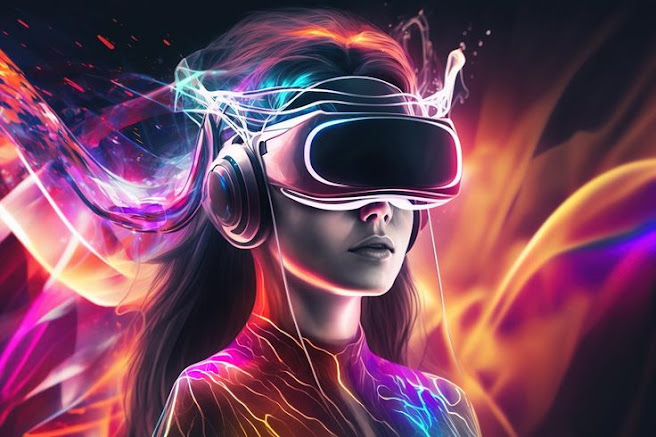In the ever-evolving landscape of technology, virtual reality (VR) has emerged as a groundbreaking innovation that has captured the imagination of millions. From immersive gaming experiences to virtual tours of far-off places, VR has made significant strides in transforming the way we interact with digital content. However, the concept of the Metaverse takes VR to an entirely new level, promising a virtual realm where people can work, socialize, play, and create like never before. In this blog post, we will explore the Metaverse, its potential impact on our lives, and the challenges and opportunities it presents.
What is the Metaverse?
The term "Metaverse" was popularized by Neal
Stephenson in his 1992 science fiction novel "Snow Crash," where it
referred to a virtual reality space inhabited by avatars of real-world users.
In essence, the Metaverse is a collective virtual shared space, merging
physical and digital realities. It is not limited to a single virtual world but
encompasses a network of interconnected virtual environments, each offering
unique experiences and interactions.
Imagine a world where you can attend meetings, concerts, or
educational seminars without leaving your home, where you can explore vast
digital landscapes with friends, and where your virtual self (avatar) can
engage in various activities ranging from business transactions to leisurely
strolls on the moon. This is the promise of the Metaverse, a space where the
boundaries between the physical and digital worlds blur, enabling users to
live, work, and socialize in a more immersive and interconnected manner.
The Building Blocks of the Metaverse
To understand the Metaverse, it's crucial to break down its essential components:
1. Virtual Reality (VR) and Augmented Reality (AR)
Virtual Reality (VR) provides the immersive digital
environment that users can access through headsets or goggles. Augmented
Reality (AR), on the other hand, overlays digital information onto the physical
world, often experienced through smartphone apps or AR glasses. These
technologies form the visual and auditory foundation of the Metaverse, creating
the sensory-rich experiences that make it so captivating.
2. Digital Identity and Avatars
In the Metaverse, users have digital representations of
themselves called avatars. These avatars can be customized to reflect users'
preferences, allowing for self-expression and individuality. Avatars serve as
the bridge between the physical and digital realms, enabling users to interact
with others in the virtual world.
3. Blockchain and Digital Ownership
Blockchain technology plays a crucial role in the Metaverse
by enabling digital ownership and secure transactions within virtual spaces.
Users can buy, sell, and trade virtual assets, such as virtual real estate,
clothing for avatars, or even digital art, using cryptocurrencies and
blockchain-based smart contracts.
4. Interoperability
For the Metaverse to reach its full potential, different
virtual worlds and platforms must be interconnected, allowing users to move
seamlessly between them. Interoperability ensures that your avatar, assets, and
social connections can be carried across various virtual environments,
fostering a more unified and expansive Metaverse.
The Promise of the Metaverse
Enhanced Social Interaction: The Metaverse aims to revolutionize social interaction by enabling more immersive and meaningful connections. Instead of scrolling through text-based feeds or participating in video calls, users can meet in shared virtual spaces, making conversations and experiences feel more natural and engaging.
New Economic Opportunities: Just as the internet created new opportunities for businesses and entrepreneurs, the Metaverse is poised to introduce novel economic models. Virtual real estate, digital services, and the sale of virtual assets are already becoming lucrative markets, with the potential for job opportunities in fields such as virtual architecture and event planning.
Education and Training: The Metaverse offers a unique platform for immersive learning experiences. From virtual classrooms to training simulations, it can revolutionize education and skill development by providing hands-on, interactive experiences.
Entertainment: The entertainment industry is already exploring the possibilities of the Metaverse. Concerts, sports events, and art exhibitions can all be brought to life in virtual spaces, allowing people to enjoy these experiences from the comfort of their homes.
Collaborative Workspaces: The way we work is changing, and
the Metaverse can redefine remote work by providing collaborative virtual
offices. Teams can meet, brainstorm, and work together as if they were in the
same physical space, regardless of their geographical locations.
Challenges and Concerns
While the potential of the Metaverse is exciting, it also raises several important challenges and concerns:
Privacy: With increased digital presence comes heightened concerns about privacy and data security. As users spend more time in virtual environments, safeguarding their personal information becomes paramount.
Digital Divide: Access to the Metaverse requires robust internet connections and expensive hardware, potentially exacerbating existing inequalities in access to technology and opportunities.
Content Regulation: Just as in the real world, issues of content moderation, censorship, and the spread of misinformation are critical concerns within the Metaverse.
Monopoly and Centralization: There is a risk that a few
dominant companies could control key aspects of the Metaverse, limiting
competition and innovation.
The Road Ahead
The development of the Metaverse is still in its infancy, with various tech giants, startups, and visionaries working towards its realization. Collaboration among these entities will be crucial in shaping a Metaverse that is open, inclusive, and accessible to all.
As we navigate the uncharted territory of the Metaverse,
it's essential to strike a balance between innovation and responsibility.
Ensuring that users' rights, privacy, and security are protected will be
paramount in building a Metaverse that enriches our lives and expands the
possibilities of human interaction and creativity.






.jpeg)




.png)
0 Comments